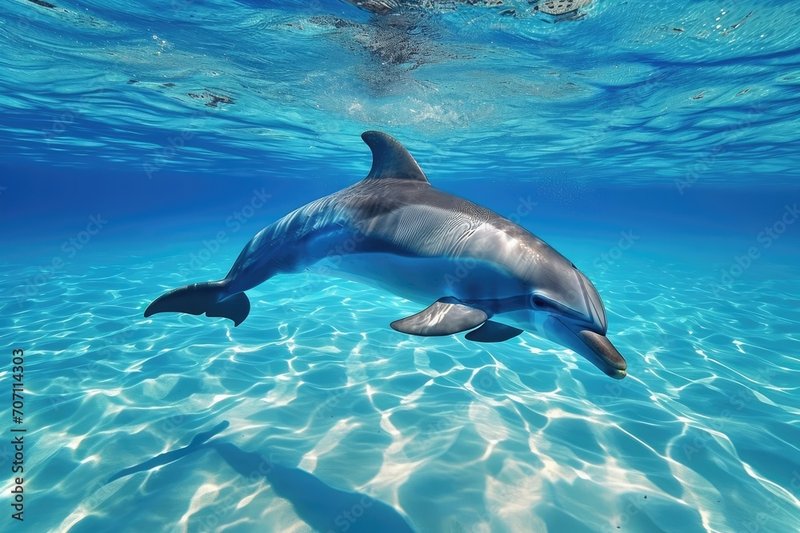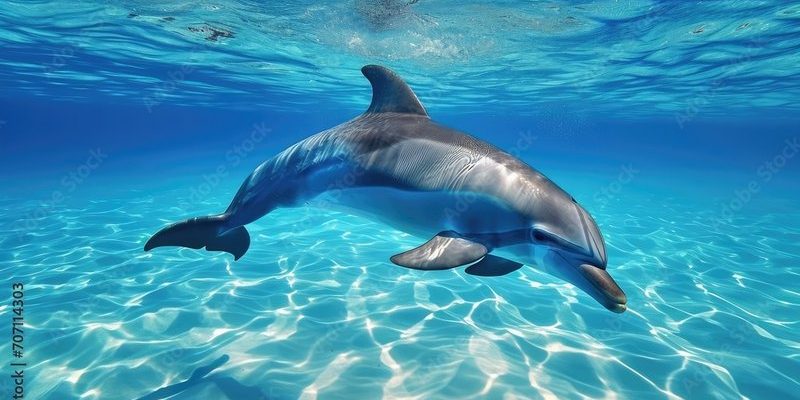
Imagine trying to find your way in a vast, dark forest. You’d likely rely on sound, sight, and maybe even your sense of smell to figure out where to go. Dolphins do something similar, but instead of a forest, they navigate through the deep, often murky ocean waters, using echolocation to detect their surroundings. And just like you might use your voice to call out to a friend, dolphins have a unique way of communicating that helps them stay connected with their pod. Let’s dive deeper into how these enchanting creatures find their way and talk to each other.
The Magic of Echolocation
Echolocation is like having a built-in sonar system. When a bottlenose dolphin clicks its mouth, it sends out sound waves that bounce off objects in the water. By listening to the echoes that return, the dolphin can determine the size, shape, and even the distance of those objects. It’s an extraordinary skill that allows them to hunt for fish, avoid predators, and navigate through complex underwater terrains.
Here’s the thing: this isn’t just a passive skill. Dolphins are actively using echolocation to gather information constantly. By changing the frequency and pattern of their clicks, they can adjust the details they receive. For example, a dolphin hunting for small fish might use rapid clicks to get detailed readings on its prey’s location. It’s like tuning a radio to catch a specific station; they adjust to get the clearest picture of their environment.
Moreover, echolocation isn’t just important for finding food. It also plays a crucial role in social interactions within a pod. When dolphins are communicating with each other, they often use a mix of clicks and whistles. These sounds can convey status, location, or even emotional states. Imagine trying to coordinate with friends in a crowded space; using sound to locate each other makes things a lot easier. Dolphins achieve this through their complex vocalizations.
Dolphin Communication: More Than Just Whistles
Dolphins aren’t just using clicks; they also produce a range of whistles that serve various purposes. These whistles can be soft, loud, high-pitched, or low, and they help dolphins identify each other and express emotions. It’s a bit like how we use tone and pitch in our speech to convey different feelings. A soft tone might indicate friendliness, while a loud tone could signal excitement or danger.
What’s fascinating is that each dolphin has its own unique whistle, often referred to as its “signature whistle.” This is like a name that other dolphins recognize. When they hear this specific whistle, they know exactly who is calling out to them, even from a distance. Isn’t that incredible? Just think about how comforting it would be to hear a familiar voice while navigating through a busy crowd.
Additionally, researchers suggest that dolphins can even mimic each other’s sounds, which showcases their adaptability and social intelligence. They’re creating a sort of underwater language, filled with nuances and meanings that scientists are just beginning to unravel. Dolphins are essentially holding conversations, sharing information about their environment and emotions, much like we do.
Navigating the Ocean’s Depths
The ocean can be a tricky place to navigate, especially with changing currents, depths, and the occasional lurking predator. Bottlenose dolphins have a few tricks up their sleeves to make this easier. Along with echolocation, they also rely on their keen eyesight and an understanding of ocean currents. You might think of them as natural navigators, using a mix of technology and intuition.
For instance, they can see well even in dim light, which helps them during a hunt at dawn or dusk when many fish are more active. Their well-developed sense of sight allows them to spot prey or obstacles from a distance. It’s a bit like driving in the dark—you want good headlights to see what’s ahead.
Dolphins also seem to use landmarks and geographic features, much like how we might navigate using road signs or distinctive buildings. They can remember the layouts of coastlines and underwater structures, which aids in their movement and hunting strategies. This knowledge is likely passed down through generations, as young dolphins learn from their mothers and pods.
The Role of Social Structure
Bottlenose dolphins are highly social creatures. They live in groups called pods, which can range from a few individuals to over a hundred. This social structure plays a significant role in how they navigate and communicate. Being part of a pod means they can share information about food sources, migration routes, and safety. Imagine traveling in a group of friends versus going solo; there’s safety in numbers.
Within a pod, dolphins often engage in cooperative hunting. They work together to herd fish into tight groups, making it easier to catch them. This teamwork requires a high level of communication. They might use specific sounds or movements to coordinate their actions, allowing them to outsmart their prey. It’s a well-orchestrated dance of sound and movement.
Moreover, the bond between pod members can be incredibly strong. Dolphins often display affectionate behaviors like touching and rubbing against one another. These interactions not only reinforce social bonds but also play a role in communication. It’s like how we show support to our friends through body language and proximity.
The Impact of Human Activity
Despite their remarkable abilities, dolphins face significant challenges due to human activities. Pollution, fishing, and climate change can disrupt their habitat and communication. For instance, noise pollution from ships can interfere with their echolocation and communication, leading to confusion and stress. Imagine trying to hear a friend in a loud, crowded restaurant—it becomes increasingly difficult.
Additionally, habitat degradation can limit their access to prey and affect their social structures. When dolphins are forced to change their traditional hunting grounds, it can lead to less efficient foraging and communication. That’s why conservation efforts are essential. By protecting their environment, we’re ensuring that these incredible animals can continue to thrive and communicate effectively.
Conservation also means being mindful of our interactions with their oceans. Simple actions like reducing plastic use, supporting sustainable seafood, and advocating for marine protected areas can make a difference in dolphin populations and the health of the broader ecosystem.
Bottlenose dolphins are more than just charming aquatic entertainers. Their ability to navigate the ocean and communicate within their pods showcases their intelligence and adaptability. Through echolocation, vocalizations, and strong social bonds, they manage to thrive in a complex underwater world.
As we learn more about these amazing animals, it’s crucial to remember the impact we have on their environment. By taking steps to protect their habitats, we can ensure that future generations of dolphins continue to navigate and communicate in the oceans as they have for thousands of years. Let’s celebrate their remarkable skills and work together to safeguard their future.

